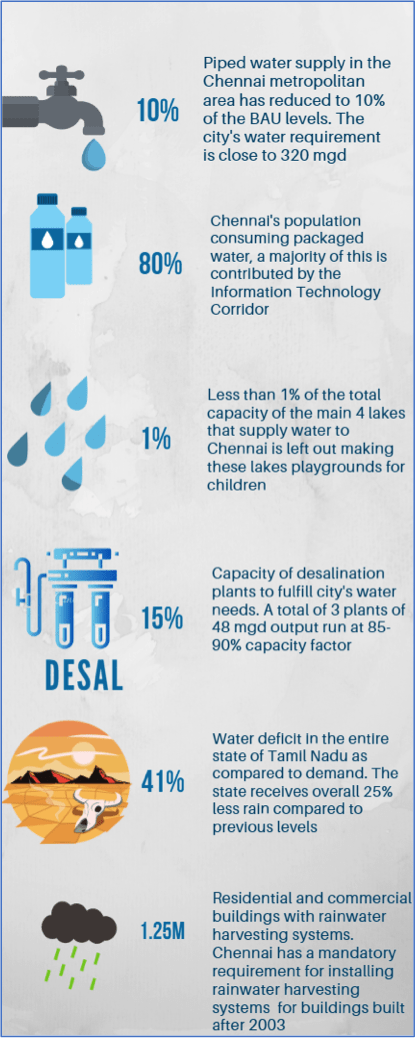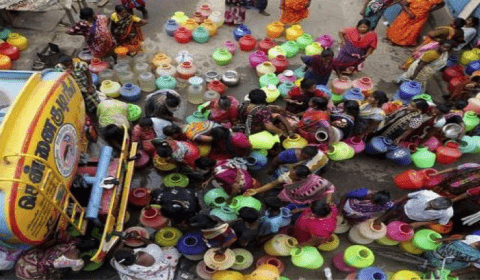Climate change is not the only reason to blame for India’s Chennai water crisis

Chennai, capital of the southern state of Tamil Nadu in India has been trending on social media in the wake of its acute water crisis. Chennai’s water shortage is so severe that it has made international news. Water problems are not new to the Indian population. Water is regarded as “Blue Gold” due to extreme scarcity and a high price. With the government’s negligence, every summer story is the same and people continue to suffer. Approximately 600 million people face high to extreme water stress in India, according to the Composite Water Quality Index report1. With nearly 70% of water being contaminated, India is placed at 120 amongst 122 countries in the water quality index. Such a water shortage is evidenced by the current water crisis in Chennai in the state of Tamil Nadu. The water supply through pipes to homes in Chennai has shrunken to 10% of what it used to be and waiting for a water tanker that supplies limited water can take as long as three to four weeks. All the four major reservoirs-Red Hills, Cholavaram, Poondi, and Chembarambakkam, that contribute 60% of the city’s requirements have dried to less than 1% of their original capacity. With no signs of water, the lakes have dried up and cracked and have turned into playgrounds for children. Chennai has gone without a single drop of rain for 200 days at a stretch and is experiencing its worst water crisis in 30 years. It is headed to becoming a zero city.
Even though the water demand is 320 million gallons per day (mgd), the city used to supply only 220 mgd even in the business as usual scenario (BAU; Economic Times). Currently, according to official sources, the supply is approximately 135 mgd. Urbanization with poor planning has aggravated this issue. The water crisis is not uniform across Chennai. Unplanned infrastructural development, lack of government regulation and implementation of existing rules under expert supervision are the primary reasons for depleting groundwater levels in major cities like Chennai. The fast growth of infrastructure has also hampered the groundwater recharge process. Even though rainwater harvesting is mandatory in residential and commercial buildings, due to low maintenance, these systems are inefficient.
Background
A large urban population means a high demand for water throughout the year which is a concern considering Chennai’s unpredictable rainfall. However, one cannot assume that only rain can save Chennai. Rain combined with appropriate storage mechanisms is the key to solving water scarcity. Chennai lacks enough storage systems for water, resulting in a very high runoff of rainwater. The water storage systems were designed with 1960’s population density in mind and currently, the infrastructure is not sufficient to fulfill the city’s water demand. This led to an increased rate in drilling underground wells known as ‘borewells’ for water. The city’s significant water demand is fulfilled by these borewells which in most cases are not owned by the city government. During the ’90s, several other water sources were assessed including the ones on farmlands, interstate rivers, and other groundwater resources. Even though Chennai’s water system evolved based on need, water planning did not have a proactive approach, thus resulting in the current situation.
Several situations have also led to interstate water conflicts such as the ‘Kaveri river conflict’ with the neighboring state of Karnataka. Although neighboring states offered to supply a certain quantity of water through their rivers, they were provisional arrangements and not permanent solutions. All these mechanisms were not enough to fulfill the demand of ever-growing population density of Chennai. Due to Chennai’s hot summer temperatures reaching as high as 45-500C, a fifth of the water is lost due to evaporation. Many of the groundwater sources are impacted by salt intrusion and not suitable for consumption without proper treatment. Therefore, the city government opted for solutions such as desalination since Chennai is a coastal city and has abundant seawater. In summary, Chennai relied on a provisional approach to fulfilling water demand as opposed to innovative options until recently. The water shortage problem has various dimensions including climate change, social disparity, and resource mismanagement.

Climate Change
It has become somewhat fashionable to blame everything on climate change. However, in the Chennai scenario, climate change does have a role to play. The number of rain days has gone down drastically and unless proper infrastructure to harvest rainwater is in place rainwater run-offs are very high due to topography. Second, as the temperature rises, energy and water demand increase to cool the buildings during heat waves. The temperature in Chennai summers is so high that nearly a fifth of the total water simply evaporates hence reducing the supply. Due to lack of infrastructure to “soak” the rain-water, the proportion of runoffs to recharge are high, which ironically, makes the city flood-prone. Chennai is highly vulnerable to climate change both in terms of ‘water balance sheet’ and coastal resilience.
Urbanization
While it is OK to allocate some responsibility to climate change, Chennai is also paying a price for its long-term downright disrespect to water bodies and sources. Chennai and its two neighboring districts – Kancheepuram and Tiruvallur – together are called ‘Yeri (lake in Tamil) districts’. The three districts had more than 6,000 lakes and reservoirs that minimized loss of rainwater by run-off and contributed to the replenishment of the groundwater table throughout the year. At present, authorities say only 3,896 exist and Chennai city alone has lost nearly 150 such water bodies. Almost 2400 acres of water bodies disappeared during the process of urbanization3. Successive governments promoted housing projects by significantly converting water bodies into residential plots and apartments to accommodate the city’s burgeoning population, which has resulted in canals and supply routes disappearing during the process. The population of the extended area has nearly doubled since 1991. Even though restoration and preservation of lakes and tanks have been in the picture, only 5 water bodies out of 210 have been desilted and restored despite the annual increase in government funds for this cause. The restoration efforts have also been ad-hoc, with communities in many areas taking up restoration on their own with help from NGOs.
Social disparity
There is a huge disparity in access to water as well as water consumption among various sections of people. For example, municipalities assume that people living in slums can get away with a few gallons of water a day and have no need for a household municipal pipeline. What puzzles the most in India’s water crises is that while the lives of some communities seem completely disrupted, a few other communities are untouched by such a devastating problem. This disparity is an impediment to meaningful action- for every person scheduling their day around water, there is one other person who is completely unaffected. This disparity spans across geography, income class, and water quantity. Some affluent areas receive piped water regularly while slums must wait for a water tanker that dispenses a limited amount of water. There is no fixed schedule for these tankers to arrive and people wait for hours to obtain a few gallons of water. Women save water from washing dishes and showering for flushing their toilets. Neighborhoods with lower population density and plenty of green cover that allows water to permeate below, represent affluent or wealthy communities. In the middle are those who have run out of their own household groundwater wells and rely on tankers to fulfill their water needs. But for the poor, their lives revolve around water schedule. Some communities have exhausted their groundwater and had no municipal supply for weeks. This situation is worse than the ‘day zero’ scenario of Cape Town where water is rationed to each person. Another dimension of disparity is the quantity of use. Many schools can’t provide water for drinking and bathroom purposes. Restaurants and commercial operations are shifting to paper and plastic cutlery to deal with the water issue, creating a solid waste-related problem. Other large users of water such as hotels, IT companies, and builders had developed their business model over decades by assuming the low cost and plentiful groundwater and their operation is now being challenged.

Resource (mis)management
One of the prominent questions to ask in this or any other unusual situation is “Why resources are managed so poorly?” The clear answer is that they don’t think it is scarce and that they can get away with it. There is a false sense of abundance among consumers and they don’t know how much water is withdrawn from underground and surface. Chennai is overdrawing groundwater by over 1.85 times the acceptable rate4. Faulty public infrastructure planning makes Indian cities smaller which implies that the urban water bodies are an attractive parcel of land for development work. Many new developments in the peri-urban areas depend on borewell water and do not have municipal water connections. They don’t ask for a municipal water connection until the underground water is emptied. Another level of mismanagement is the lack of data. It is unbelievable that in a city as large as Chennai, there is no accurately metered data on actual water use. The uncertainty of water use data is very high due to multiple sources of water used, lack of municipal pipe connections, and unmanaged water meters. As the urbanization increased, the area covered by impervious surface has increased, and greening efforts by the city are not very significant. In addition, mandatory rainwater harvesting has been suffering from poor planning and enforcement. According to a survey by the Rain Center, over 50% of the structures were found with non-compliant rainwater harvesting system. The rivers are filled with filth and untreated sewer water for over decades and no significant measures are taken for their clean up.
Good practices to fight crisis
Chennai’s topography needs solutions such as rainwater harvesting and desalination plants. During the 2011-16 Jayalalithaa (former Chief Minister of Tamil Nadu) regime, having rainwater structures in every building was made mandatory and that coercive policy is now credited with having helped the city in a big way even though quantitative data are not available. Today Chennai has three desalination plants – two of 12 mgd each and the other of 24 mgd. Chennai is now relying on 3 desalination plants with a combined capacity of 48 mgd. The tanks and reservoirs were desilted last year which increased the available water quantity slightly to manage the current crisis. There are other localized efforts to restore and rejuvenate water bodies. Several commercial operations are finding ways to reuse wastewater for secondary applications such as flushing toilets and air-conditioning.
In a nutshell
Understanding the demand for water is the key to solving water scarcity issues particularly in Chennai. For the poor, who stand in line giving up their sleep to fill up their 5-gallon pots/buckets have a clear understanding of how much water they use for what purpose. On the other hand, people who get water whenever they open taps have no understanding of their water use. Metered data collection is necessary for the city(ies) to understand the demand to implement a better supply regime. Policy mandates such as not allowing extraction of groundwater for private home use, reuse of wastewater in commercial operations and measures to address inequality in water quantity supplied to different social class need a thorough consideration. In several other countries, water is the property of the government and there are regulations that ban having private wells or groundwater pumps. On the contrary, in Chennai, like any other city in India, there is an exceedingly high rate of private groundwater extraction which needs to stop immediately. Localized efforts in restoring local lakes and tanks, mandating large water users to reuse wastewater, efficiently managing rainwater harvesting systems that are already in place, collecting better data through meters and reducing water use, in general, makes the governments have a facilitative role and helps implement good practices much faster. This is a major behavioral change that stakeholders at all levels need to make to deal with and eliminate such a crisis in the future.
- Composite Water Management Index ↩
- Chennai’s Day Zero: It’s not just meteorology but mismanagement that’s made the city run dry ↩
- Seven reasons why Chennai should have seen this water crisis coming ↩
- Chennai water crisis: How ‘great’ teamwork, muddy data enabled poor management and engineered a disaster ↩

